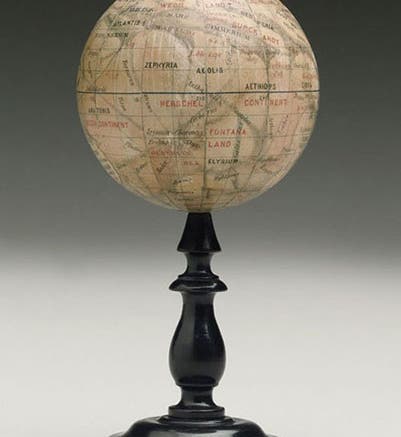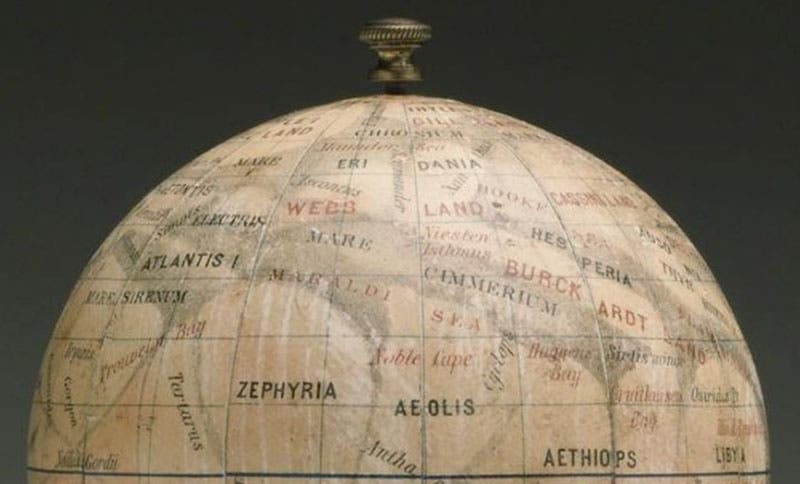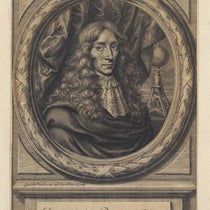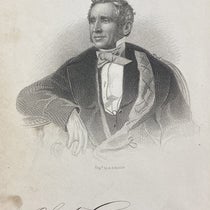Scientist of the Day - Louis Niesten
Jean Louis Nicolas Niesten, a Belgian astronomer, was born on July 4, 1844; since July 4 birthdays never get celebrated in this forum, we chose today, July 20, as Niesten's day. He worked for most of his life for the Royal Observatory of Belgium in Brussels. His main interest was planetary astronomy, and especially Mars, which he observed during its close opposition in 1877, and on many occasions thereafter. He led an expedition to Chile to observe the transit of Venus in 1882, and another to Russia on the occasion of a total solar eclipse. He helped found a popular astronomy journal, Ciel et terre, in 1880, and contributed many articles to it over the years. His more professional papers appeared in the Annals of the Royal Observatory. We have runs of both journals, so Niesten's body of work is well represented in our Library.
But we do not have the object that we are going to discuss for the rest of this post: a globe of Mars, designed by Niesten and published by Lebeque and Co. of Brussels in 1892 (first image). It is not very large, less than 9 inches tall on its stand, with a globe about 4 inches in diameter. The globe was made from 12 gores, printed by chromolithography from a stone on a single sheet of paper, and then cut up and pasted onto a wooden and plaster sphere. We assume that the Mars globe was offered for sale, but few copies survive: there is one in Padua, and another in the Smithsonian, and one in the Science Museum, London, which Niesten gave to the Royal Astronomical Society sometime before 1910, and which was later transferred to the Science Museum. A fourth copy, a well-used one, was sold at auction by Christies in 2015, and the buyer is unknown (sixth image). There are probably others which have just not surfaced in the literature.
I have never seen a Niesten Mars globe in the flesh, so to speak, and I would very much like to do so. What intrigues me about Niesten's globe is that it incorporates both of the popular systems of Martian nomenclature that had been proposed after 1877 and were vying for acceptance in 1892. The Italian astronomer, Giovanni Schiaparelli, had named all the features on Mars with Latin geographical terms, such as Syris Major and Solis Lacus, the two most prominent landmarks on Mars. Nathaniel Green, an English astronomer, following the lead of his countryman Richard Proctor, named the surface features after astronomers who had studied Mars, giving us Herschel Land and the Dawes Sea. As we see in the detail of Niesten’s globe of Mars (fourth image), he printed Schiaparelli’s names in black, and Green’s in red, so we find Solis L[acus] in black, as well as Kepler Land and the Terby Sea in red. Perhaps Niesten was ensuring that his globe would still be useable, no matter what future astronomers decided.
The odd thing about the debate over a proper Martian nomenclature is that 220 years earlier, there had been a similar debate over lunar nomenclature, with Johannes Hevelius proposing to name the Moon’s features after ancient Latin geographical terms, and Giovanni Battista Riccioli opting for a system based on the names of astronomers. On that occasion, the system using the names of astronomers won out. With Mars, it went the other way. Go figure!
Some 8 years after his globe was issued, Niesten published an article on Mars in the Annals of the Brussels Observatory, where he included, at the end, a plate of gores for a Martian globe (fifth image). I am not sure, but I think it might have been printed from the very stone that was used to print the gores for the 1892 globe. Annals, you could have cut out the gores and made your own globe, assuming you had a 4-inch wooden or plaster ball lying around the house.
If anyone knows of a Niesten Mars globe on exhibit anywhere, other than the ones I have mentioned here, please let me know. Here is the link for the globe at the National Museum of American History at the Smithsonian, but I do not believe it is on display.
William B. Ashworth, Jr., Consultant for the History of Science, Linda Hall Library and Associate Professor emeritus, Department of History, University of Missouri-Kansas City. Comments or corrections are welcome; please direct to ashworthw@umkc.edu.












